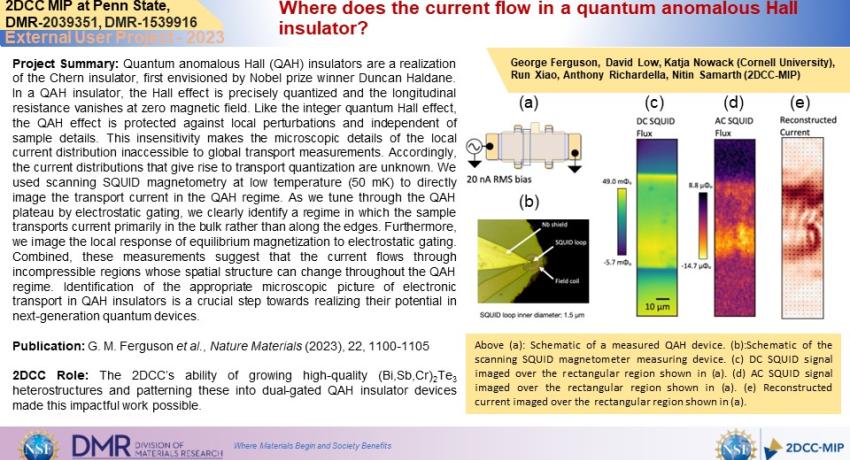Quantum anomalous Hall (QAH) insulators are a realization of the Chern insulator, first envisioned by Nobel prize winner Duncan Haldane. In a QAH insulator, the Hall effect is precisely quantized and the longitudinal resistance vanishes at zero magnetic field. Like the integer quantum Hall effect, the QAH effect is protected against local perturbations and independent of sample details. This insensitivity makes the microscopic details of the local current distribution inaccessible to global transport measurements. Accordingly, the current distributions that give rise to transport quantization are unknown. We used scanning SQUID magnetometry at low temperature (50 mK) to directly image the transport current in the QAH regime. As we tune through the QAH plateau by electrostatic gating, we clearly identify a regime in which the sample transports current primarily in the bulk rather than along the edges. Furthermore, we image the local response of equilibrium magnetization to electrostatic gating. Combined, these measurements suggest that the current flows through incompressible regions whose spatial structure can change throughout the QAH regime. Identification of the appropriate microscopic picture of electronic transport in QAH insulators is a crucial step towards realizing their potential in next-generation quantum devices.
2DCC Role: The 2DCC’s ability to grow high-quality (Bi,Sb,Cr)2Te3 heterostructures and pattern these into dual-gated QAH insulator devices made this impactful work possible.
What Has Been Achieved: This work provided the first direct measurement of the current distribution in a quantum anomalous Hall insulator. The experiment used a unique scanning SQUID magnetometer technique that works at very low temperatures (50 mK). The experiment revealed that current flows in the bulk as well as at the edges even in the precisely quantized anomalous Hall state.
Importance of the Achievement: Direct measurements of current flow in topological states such as the quantum Hall insulator have been long sought in order to validate theoretical ideas. However, this is not possible because sensitive scanning magnetometers cannot operate in the high magnetic fields needed for the quantum Hall effect. This experiment exploited the fact that quantum anomalous Hall insulators show quantized states at zero magnetic field. This experiment provides important new insights into a controversial issue in the quantum Hall effect and brings much-needed clarity into the nature of current flow in quantum anomalous Hall insulators.
Unique Feature(s) of the MIP that Enabled this Achievement: Synthesis of high-quality Cr-doped (Bi,Sb)2Te3/(Bi,Sb)2Te3/Cr-doped (Bi,Sb)2Te3 trilayer heterostructures by MBE and fabrication of dual-gated Hall bar devices which show precisely quantized behavior.
Publication: G. M. Ferguson, R. Xiao, A. R. Richardella, D. Low, N. Samarth, K. C. Nowack, “Direct visualization of electronic transport in a quantum anomalous Hall insulator,” Nature Materials (2023), 22, 1100-1105. https://doi.org/10.1038/s41563-023-01345-1
Acknowledgments: Work at Cornell University was primarily supported by the US Department of Energy, Office of Basic Energy Sciences, Division of Materials Sciences and Engineering, under award no. DE-SC0015947. Sample synthesis and fabrication at Penn State was supported by the Penn State 2DCC-MIP under NSF Grant nos. DMR-1539916 and DMR-2039351.
